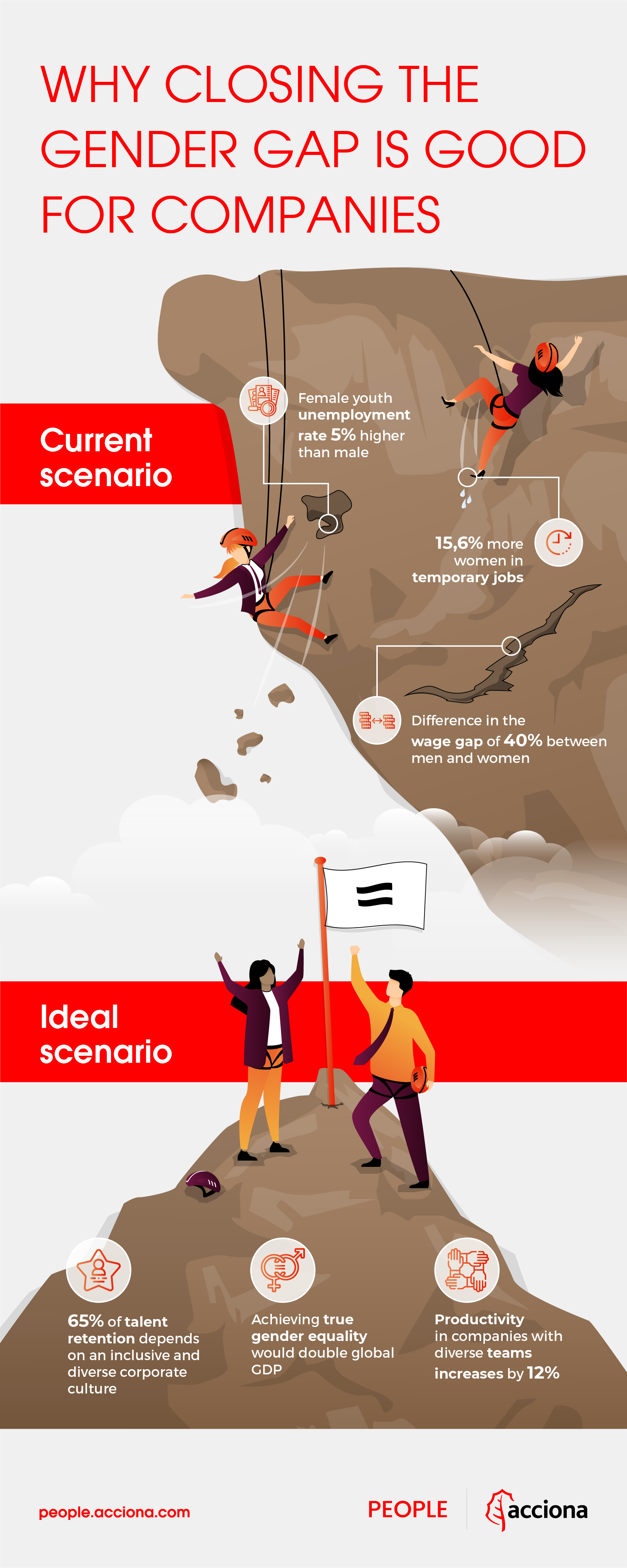If the gender pay gap is worrying, the pension gap between women and men should be even more so. While wage differences are around 16% on average in the European Union according to data from the European Commission (2019), the differences in pensions widen to 35%, with the lowest difference in Estonia (3.1%) and the highest in Malta (44%). In the case of Spain, the differences between women’s and men’s pensions are 32.1%. This is known as the pension gender gap, and has received much less academic, media, political and public attention than it deserves.
Given this situation of financial inequality in the retirement years, together with a longer life expectancy for women, it is normal that 9 out of 10 women aged between 56 and 65 are extremely concerned about the future of their pensions, according to a BBVA survey on pensions and savings habits conducted in 2017. This inequality increases the likelihood of vulnerability, and of falling into the risk of poverty in old age. This is known as the feminisation of old age (Chinchilla, Jiménez, & Grau, 2014). To give us an idea of the difference between the average pension of a woman and a man, in February 2021, the average pension for women was 826 euros, while the average pension for men was 1250 euros. This is a more than significant gender gap, which stems from factors that go back a long way.
Women’s pensions, the effect of long-term factors
These significant gender differences in pensions can be explained by two main reasons: differences in the labour market, and the design of pension calculations themselves. Let’s start with labour market differences. As we have explained in other articles, parity is still a pending issue in many sectors. There are at least three differences in the labour market that have a negative impact on women’s future pensions. These three differences are the following:
- Lower participation of women in the labour market, with participation being understood as the activity rate (people working or actively looking for work).
- Less time spent by women in paid work, as a result of two factors:
- Fewer hours worked, as the percentage of part-time work (voluntary and non-voluntary) is higher for women than for men.
- Fewer years worked, as women interrupt their careers more often than men to take care of other family members. Just as an example, of the 17 million Spaniards aged 18 to 64 who had a child under 15, 28.13% at some point interrupted their professional career to provide care. 87.1% were women (Domínguez Fabián, Devesa Carpio, Encinas Goenechea, & Meneu Gaya, 2021).
- Lower income than men, which is the well-known gender pay gap.
However, this triple gap in the labour market (less participation, less time, less pay) not only has a negative impact on the future pension, but is also caused by the design of pension calculations themselves. Among other factors, the lack of compensation for care breaks, the limits of the non-contributory pension, the requirements for the contributory pension, the non-inclusion of informal work, and the differences in the age of access to retirement in some countries, among other factors, are argued. In addition to these strictly labour market-related factors, women also face gender bias in other aspects of everyday work, such as decision-making.
How to tackle the pension gap between women and men
For this reason, various studies propose different initiatives to promote a decent pension that guarantees the quality of life of pensioners and avoids dramatic differences between men and women in the pension system. Among other initiatives, we highlight the following:
- Provide information on the real situation of the future pension. Most people do not know what their future pension will be. Knowing this first-hand would allow citizens to consider different options in the future (Chinchilla et al., 2014).
- Diminish the penalty for career breaks. Interrupting one’s professional career for family care or other reasons not only has a penalty in the labour market itself, but also in the future calculation of the pension. It would be interesting to consider alternatives that would lower or reduce the penalties derived from interruptions in the market due to care (Chinchilla et al., 2014; Solís-Prierto, 2019).
- Guarantee basic protection for all pensioners, providing an acceptable quality of life. In Spain, the amount of the non-contributory pension was set in 2021 at a minimum of €100.70 to €402.80 per month. Can a woman who has not contributed enough years to have access to a contributory pension live in dignity? (Arza, 2015)
- Readjust pensions for those who live longer, and thus avoid a potential loss of purchasing power, which affects quality of life in old age (Arza, 2015).
Quality of life in old age is a crucially important aspect, and one of the determining factors is the pension, as it’s the main source of income enjoyed by most pensioners. As we have seen, there are important differences between men’s and women’s pensions which can have a considerable impact on their quality of life. It’s essential to keep the spotlight on ensuring a decent quality of life for all people, while thinking of alternatives to avoid staggering differences between men and women.

References
Arza, C. (2015). The gender dimensions of pension systems: policies and constraints for the protection of older women. United Nations.
Chinchilla, N., Jiménez, E., & Grau, M. (2014). Impacto de las pensiones en la mujer. Jubilación y calidad de vida en España. IESE Business School.
Domínguez Fabián, I., Devesa Carpio, E., Encinas Goenechea, B., & Meneu Gaya, R. (2021). The minimum pension and its effect on the gender gap in retirement pensions in Spain. Journal of Gender Studies, 1–15. https://doi.org/10.1080/09589236.2021.1899905
Solís-Prierto, C. (2019). Medidas paliativas frente a la brecha de género en materia de pensiones en España: crónica de su insuficiencia. Noticias CIELO, 4(3).


